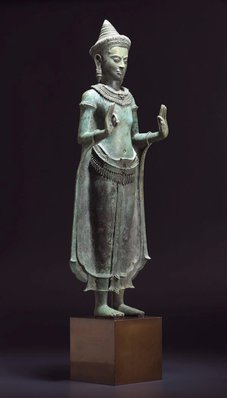

-
Details
- Place where the work was made
-
Lopburi
→
Thailand
- Cultural origin
- Khmer style
- Period
- Lopburi period 900 - 1300 → Thailand
- Date
- 12th century-13th century
- Media category
- Sculpture
- Materials used
- copper alloy
- Dimensions
-
86.0 x 27.0 x 16.0 cm; 105.0 x 27.0 x 16.0 cm object with stand
:
a - Buddha, 80.5 x 27 x 16 cm
b - crown, 8.5 x 11.2 cm
- Signature & date
Not signed. Not dated.
- Credit
- Gift of the Art Gallery Society of New South Wales 2002
- Location
- Not on display
- Accession number
- 156.2002.a-b
- Copyright
- Share
-
-
About
This finely crafted regal figure of the Buddha is depicted in a strong frontal stance wearing long, flowing monastic robes, scalloped at the hems and gathered in front with a jewelled girdle. While the smooth and naturalistic modelling of the torso gives the appearance of a bare upper body, the Buddha's robes are in fact draped over both shoulders where an elaborate necklace or collar disguises the neckline of the garment. In addition, the Buddha is depicted wearing elaborate jewellery: heavy earrings, armbands and a distinctive conical crown. The practice of depicting the Buddha as adorned with a crown developed in Pala India where the crown represented the complete attainment of Buddhahood. Nevertheless, dressed in the regalia of a king, this majestic figure of the Buddha embodies the concept of the Devaraja (literally god-king), as an incarnation of the Divine on earth and as the means by which the Khmer kings legitimised their sovereignty.
In an interesting variation, the hands of this Buddha are held in the gesture of 'vitarka mudra', the gesture of philosophical debate and discussion, reminiscent of Thai Buddha images of the preceding Mon-Dvaravati period. Thus although the distinctive facial features, powerful frontal and hieratic stance, and ornate formalism of this skilfully executed image of the Buddha has its stylistic origins with the Khmer culture, this appropriation and adaptation of Mon-Dvaravati elements attest to the dynamic evolution of Southeast Asian Buddhist sculpture.
Asian Art Dept., AGNSW, 29 May 2002.
-
Exhibition history
Shown in 1 exhibition
Walking with gods, Art Gallery of New South Wales, Sydney, 01 Jun 2019–05 Jan 2020
-
Bibliography
Referenced in 6 publications
-
Art Gallery of New South Wales, Art Gallery of New South Wales Annual Report 2002, 'Year in review', pg. 8-25, Sydney, 2002, 24.
-
Edmund Capon AM, OBE, Art Gallery of New South Wales: highlights from the collection, Sydney, 2008, 185 (colour illus.), 189 (colour illus.). The colour illus. on page 189 is a detail of this work.
-
Jackie Menzies, Look, 'Spiritual and philosophical', pg. 26, Sydney, Dec 2002-Jan 2003, cover (colour illus.), 7 (colour illus.), 26 (colour illus.).
-
Jackie Menzies, Arts of Asia, 'New Dimensions', pg. 54-63, Hong Kong, Nov 2003-Dec 2003, 60 (colour illus.). no.15
-
Jackie Menzies (Editor), The Asian Collections Art Gallery of New South Wales, Sydney, 2003, 326-327 (colour illus.). The colour illus. on page 327 is a detail of this work.
-
Judith White, Look, 'Renew with the gallery', pg. 12-13, Sydney, Nov 2002, 13 (colour illus.).
-
-
Provenance
Harry Kahn, 1989-1999, New York/United States of America
Jenny E. Kaufmann, 1999-2002, New York/United States of America, by descent from the Harry Khan estate.
Peter Marks Gallery, Mar 2002-Oct 2002, New York/United States of America, with Peter Marks Gallery (art dealership). Purchased through Peter Marks Gallery (art dealership) by the Art Gallery of New South Wales, Sydney, 2002.
